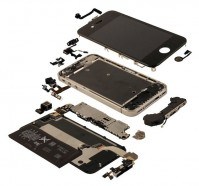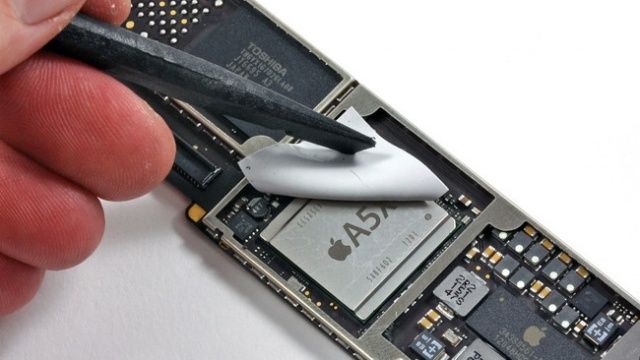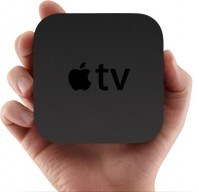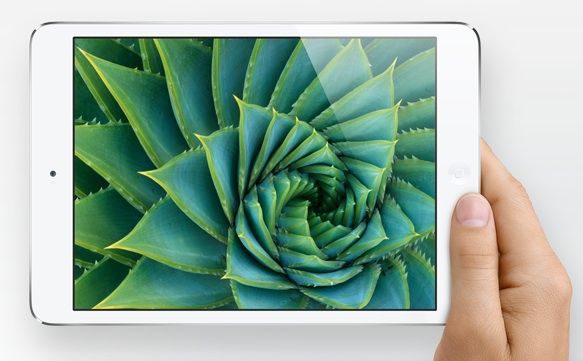Although the iPad mini is well-reviewed, a constant complaint that has been leveled against Apple’s smallest tablet is that the display isn’t Retina. In fact, in my review of the iPad mini, I could barely see past the terrible fuziness of the on-screen text, and considered it an otherwise perfect device’s Achilles’ Heel.
Over the last day or so, a lot of thinkers in the Apple space have piped up, saying that it would essentially be impossible for Apple to make the iPad mini with a Retina display.
Summarized, the argument is this: A Retina iPad mini would be too expensive for Apple to make right now, and it would come with other tradeoffs, like a significantly reduced battery life and a much thicker and heavier form factor.
I was curious if this was actually true, so I decided to try an experiment: I’d build an imaginary Retina iPad mini out of technology that Apple already has access to, add up how much it would cost, and then see what the design tradeoffs would be.
What I found out was that Apple could indeed have shipped an iPad mini with Retina this generation without significantly changing the form or battery life of the device, but it would have cost $379. Here’s why.
How Much Does An iPad Mini Currently Cost To Make?
Before we go any further, here’s some information you’ll need to keep in mind through the rest of the piece: how much the iPad mini costs for Apple to make. The answer is about $188, according to IHS iSuppli.
Here’s how that $188 breaks down:
| Component | Cost To Apple |
|---|---|
| Display & Touchscreen | $80.00 |
| Processors | $13.00 |
| Memory | $15.50 |
| Cameras | $11.00 |
| Battery | $13.50 |
| UI, Sensors, Combo Module | $15.00 |
| Other Costs | $39.50 |
| Total | $188.00 |
Overall, then, Apple’s marking every $329 iPad mini sold up by about 75%. How much would this change if Apple had shipped a Retina iPad mini instead?
How Much Would A 7.85-Inch Retina Display Cost?

As you can see above, the iPad mini’s low-res screen costs $80 between the display & touchscreen put together, or almost 24% of the total retail price of the iPad mini’s $329 entry level price. Expensive! But could we take the iPad mini’s lower-res, 1024 x 768 display and double the pixel density to Retina levels without significantly magnifying the cost?
One of the things we know about the iPad mini screen is it is effectively just an iPhone 3GS screen blown up to roughly five times the size. Here’s John Gruber of Daring Fireball explaining the concept before the iPad mini’s release:
Here’s the logic behind such a display. Displays aren’t manufactured at their finished size; rather, they’re made on big sheets, and then cut to size. I believe the iPad Mini (or whatever it’s going to be called) uses the same display as the iPhone 3GS. So instead of cutting these sheets into 3.5-inch 480 × 320 displays for the iPhone 3GS, they’ll cut them into 7.85-inch 1024 × 768 displays for the smaller iPad. Same exact display technology, though — display technology that Apple has been producing at scale ever since the original iPhone five years ago.
Gruber was right: the iPad mini screen is really just a big iPhone 3GS screen. It has about 5.12 times the pixels, but the same pixel density. Otherwise, it’s pretty much the same tech: just a sheet of iPhone 3GS display cut to 7.85 inches.
The iPad mini display is really just a big iPhone 3GS screen.
If that’s true though, it follows that Apple could make a Retina iPad mini screen by simply cutting an iPhone 4 screen to 7.85 inches too! And it’s actually not that hard to estimate what such a screen would cost.

When the iPhone 4 was originally released back in 2010 with its breakthrough Retina display, it cost Apple $38.50 each to make. How much would a 7.85-inch version of that same 326 pixel-per-inch screen cost us now? We can’t know for certain, but we can estimate.
Over time, the price Apple pays to make its screens goes down. For example, when the iPhone 3GS was first released, it cost Apple $35.25 to make each screen. Since an iPad mini screen is 5.12 times bigger than an iPhone 3GS screen, we can estimate it would have cost Apple roughly $180.48 to make a 7.85-inch 3GS screen back in 2009. But we know that now, in 2012, Apple’s only paying $80 for such a screen, or around $100 less.
So let’s make a couple of assumptions here. Let’s assume based upon the above numbers that over the last three years, the cost of making a 7.85-inch screen with 163 pixels per inch went down an average of $33 per year. Let’s further assume that if Apple was going to make a 7.85-inch screen with 326 pixels per inch using the two-year old iPhone 4 display tech, the price would similarly drop over time, or by about 36.78% over two years. Given these assumptions, here’s what we come up with.
When the iPhone 4 debuted in 2010, a 7.85-inch display with 326 pixels per inch would have cost Apple about $197.12 to produce (or 5.12 times what an iPhone 4 display would have cost Apple to make at the time). Two years later though, in 2012, that same display would cost about $123.62 for Apple to make. And by 2013? The cost of a 7.85-inch Retina display shrinks to just $109.73.
By 2013, the build cost to Apple of building a 7.85-inch Retina display should shrink to just $109.73.
We’re pretty sure this estimate is accurate, because it’s in alignment with how much the Retina iPad’s display costs. According to the third-generation iPad’s BOM, the 9.7-inch, 264ppi Retina display costs Apple $127 per device.
What About Graphics & Battery Life?

There’s not just the Retina display to consider, though. A Retina iPad mini with a 2048 x 1536 would need much better graphics to power its over 3.1MP display. And better graphics and more pixels to light up would also require a bigger battery.
The good news, though, is that the extra expenses incurred here are much more manageable, and Apple can achieve them without too many design trade-offs.
When Apple brought the Retina display to the third-gen iPad, its pixel-pushing horsepower was supplied by a 45nm A5X SoC with quad-core graphics. It was huge, and it was power hungry, necessitating a much bigger battery and a slightly thicker device footprint.
Cupertino could put a 32nm A5X chip into a Retina iPad mini.
The thing to remember here, though, is that Apple’s no longer designing 45nm chips. Instead, they are now designing all their chips — the A5, the A6 and the A6X — using a 32nm process. Since the smaller the process, the more power efficient a chip is, Cupertino could put a 32nm A5X chip into a Retina iPad mini without it being nearly as power hungry.
How much more power efficient would a 32nm A5X be? Well, when the iPad 2 stopped shipping with a 45nm A5 chip and switched to one built with a 32nm process, it actually saw a 29% battery life boost in graphically challenging tasks.
It’s true that, even so, the iPad mini’s battery would need to increase in capacity if it wanted to keep up with the Retina display. But the Retina iPad improved the iPad 2’s battery from 6,944 mAh to 11,666 mAh (or by about 68%) while largely staying the same size: the third-gen iPad is only 7.6% heavier and 6.8% thicker than the iPad 2…. and that’s without the power savings of a chip based upon a 32nm process. It’s possible that Apple could have managed to keep the thickness and width of a third-gen iPad using a 32nm A5X chip the same as the previous generation.
In our mind, then, a Retina iPad mini should be possible with a 32nm A5X chip and denser (but not substantially bigger, physically) battery. How much would that cost?
Well, looking back, we can see that when the A5 processor started being manufactured with a 32nm process, the cost to manufacture it stayed about the same: around $14. So a 32nm A5X processor should cost about the same to make as the 45nm version did, or about $23. Since the current iPad mini uses a 32nm A5 processor that costs $14, this would add about $9 to the manufacturing cost of a Retina iPad mini.
As for the battery, the iPad 2’s smaller battery cost Apple $22.75 each, compared to the Retina iPad’s $32 battery. The iPad mini’s battery currently costs Apple $13.50 each to make, so a 68% bigger battery with a large enough capacity to drive a Retina display would probably cost around $18.90 to make.
So in the worst case scenario, a Retina iPad mini with a battery big enough to drive a 2048 x 1536 display and an A5X chip would add about $14.40 to the cost of the device, and increase the weight by about 20 grams and the thickness by about 0.2 inches.
How Much Would A Retina iPad Mini Cost Apple?
Given all the above, and assuming everything else stays the same, here’s what it would cost Apple to release a Retina iPad mini in 2012:
| Component | Current Cost | Retina Cost |
|---|---|---|
| Display & Touchscreen | $80.00 | $123.62 |
| Processors | $13.00 | $23.00 |
| Memory | $15.50 | $15.50 |
| Cameras | $11.00 | $11.00 |
| Battery | $13.50 | $18.90 |
| UI, Sensors, Combo Module | $15.00 | $15.00 |
| Other Costs | $39.50 | $39.50 |
| Total | $188.00 | $246.52 |
Apple’s markup on the iPad mini just shrank from 75% to 33%. And that’s without including things like marketing, shipping and so on. Include those things, and the Retina iPad mini isn’t making Apple much money at all. In fact, it would probably almost be a break-even product for Apple.

There’s just no way that Apple would ever accept a markup on an iPad that low. Apple’s markup on the $399 iPad 2 is 63%. Apple’s markup on the third-gen iPad is at least 57%, and if you buy a 64GB iPad WiFi + Cellular, that markup shoots up to over 102%! Like the iPhone, Apple’s strategy isn’t to sell their hardware at a loss, like Google or Amazon, but to make a tidy profit on every unit sold.
To put how small this markup is in perspective, the Apple TV has a markup of around 35%, and Apple has publicly derided that product as a “hobby” for years. Why? They can’t make real money on the hardware.
The last thing Apple wants is for the iPad mini to be a hobby: when it’s not dicking around, Apple’s core pricing strategy requires a markup of at least 50%. The smallest markup you see on an iPad is 57%. Give an iPad mini with Retina display the same markup, and you’re looking at a 16GB model starting at around $379.
Conclusion

This feature is admittedly filled with assumptions. Assumptions that iSuppli’s build-of-materials breakdowns are right. Assumptions that hardware costs will continue to fall as they historically have done. Assumptions that Apple would reuse old technology to make an iPad mini with Retina display.
None of those assumptions, however, are inherently ridiculous, and if they are true, my conclusion is that Apple could make an iPad mini with Retina display right now, using technology they already have available, but they would have to raise the price by $50 per unit to an entry-level price of at least $379.
In 2013, though, if the cost of memory and components continue to fall, it should be possible to build that same iPad mini with Retina display while still achieving a markup of over 50%, which is within Apple’s comfort zone, at the current price of $329. The second-gen iPad mini with Retina would have a 2048 x 1536 display with 326 pixels-per-inch, a 1GHz A5X processor with quad-core graphics built with a 32nm process, and a bigger battery that could, in a worse case scenario, make the iPad mini about 20 grams heavier and cause it to take longer to charge to 100%.
Those are reasonable trade-offs, ones Apple has made before with the third- and fourth-gen iPad, so having done all the math, the biggest question I’m left with is, “if Apple could have released an iPad mini with Retina display this generation, but would have to price it at $379 instead of $329, why didn’t they?”
There are a lot of possible reasons. Is it because a $379 iPad mini with Retina display is too expensive to compete with 7-inch competitors like the Nexus 7 and Kindle Fire HD 7? Possibly, but the iPad mini is already over a hundred dollars more than those tablets, and Apple has never stressed out trying to “compete” in price with cheap crap.
Or is it because the linchpin of an iPad mini with Retina display is a 32nm A5X chips, which doesn’t exist right now? Sure, Apple could make one, but in the last year alone, they’ve redesigned the A5 to be 32nm, and also created new 32nm A6 and A6X chips. Perhaps just one more chip to design, make, and test this year was just too much for Apple.
Either way, if we’re right, the second-gen iPad mini is a shoo-in to have a Retina display. It’s just a matter of time.
![Why An iPad Mini With Retina Display Would Have Cost $379 [Feature] ipad-mini-ground](https://www.cultofmac.com/wp-content/uploads/2012/11/ipad-mini-ground-e1352910973426.jpg)


18 responses to “Why An iPad Mini With Retina Display Would Have Cost $379 [Feature]”
$379 is STILL cheaper than what the price of an iPad mini equates to in the UK! We’re currently being charged the equivalent of ~$429 for an iPad mini here just now and its still selling.
I didn’t buy my wife an iPad mini because it wasn’t retina display. I felt the step back wasnt a good step to take for her for the expense. So next year she will be an owner of the iPad mini 2 or the new iPad mini whatever they call it :P
Would the mini still be mini with a Retina screen? The case might need to be larger to accomodate the bigger backlight for the Retina display. And then the battery might need to be bigger to accomodate the backlight, screen and updated CPU. Would the mini still be the same? Would it get too warm? Perhaps Apple should just wait on Sharp’s IZGO display?
Well, that’s with all sort of VAT taxes added on top of it. I feel your pain, though: I lived in Europe for ten years and it was always a bitter pill to swallow.
This feature didn’t end the way I foresaw it would, you’ve made a prediction about the next version when you were originally setting out why you think it could of worked this time round. Theres no real conclusion to the piece, it’s like the end came from another article altogether =/
Personally I want the Mini with retina. Price is irrelevant, but I wouldn’t want it to be twice as thick and twice as heavy.
The iPad 2 to iPad 3 was a step backwards, IMHO, despite the retina screen. Great screen, but too many compromises were required in order to support it.
the ipad 3 gave you 4 time the resolution of your crappy ipad 2, 2 times the ram, 2 times the power, 5 times the camera resolution and upgraded your bluetooth while keeping the same price and because the increased the weight by less than 8% and thickness by less than 7% there’s too many compromises?
ur the biggest moron on earth
Having used the Mini for a while now, I can say, with 100% honesty, there isn’t a damn thing wrong with that display.
I agree with the first comment posted here.
Also, a giant iPhone 3GS? That’s seriously not the case. Want my iPhone 3GS to compare? The features of the iPad Mini surpass those of the iPad 2, the screen and pixels are greatly improved, along with the addition of Siri and so many other things. I didn’t order it until I saw all of the specs and features on Apple’s site, then I decided to get that. The funny part is I started out looking at a Kindle reader, then Kindle Fire HD which is not very good at all, a Nexus which I did not like, and just as when I purchased my first Apple device ever, the iPhone, I ended up ordering the iPad mini. I love the 8″ size or 7.9″, and the light weight and how thin it is as well.
If I had waited to get a new full sized iPad, I would have gotten the new 4th generation iPad, but it’s not different enough than the iPad 3 to consider purchasing. Microsoft RT is not even a consideration in our home.
Sigh…never ceases to amaze how deep in denial apple fanatics are.
from ipad 2 to ipad 3, there’re a lot of compromise in order to fit the retina screen, i think during that time the screen technology was still new. now, maybe there’s a good enough technology to add in the retina screen without the need to compromise (or less compromise) on other factor. played with one mini, the screen is ok, really. but surely i will hope for retina for even greater reading experience.
So your saying the screen of the nexus 7 or the Fire HD is inferior to the ipad mini?
Geez….this apple kool aid must numb more than just eyesight and comprehension.
If you remove VAT the device costs £224, which is about $355. Not quite 429 but still ridiculously high.
Why? Because he doesn’t have a problem with the display? I looked at one over the weekend. I don’t have a problem with display either.
retina display owners must be blind, dumb or both
you too should be a serious Darwin Awards nominee
I love my iPad mini! It is by far my favorite i-device to date. The non-retina display to me is sharp and crisp. No fuzziness at all. In fact, it’s so comfortable to hold, clean and crisp to read and light – that I prefer holding and reading off of the screen to any other device I’ve seen or used so far. I think that a retina iPad mini might be a bit heavier, may have a greater charging time and would not be so ‘mini’.
the mini retina is not so mini, it kept the same bezel size with an increased thickness of 3.5% and weight of 6.5%, this is a huge difference
you are a serious Darwin Awards nominee
keep your crap ipad 2 spec mini